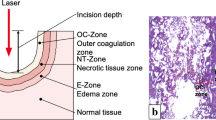Abstract
It is assumed that a pulsed Nd-YAG laser will avoid heat diffusion in tissue and thus produce more predictable and less deep lesions. The aim of this study was to compare lesions induced in an homogeneous tissue by the pulsed wave (PW) and the continuous wave (CW) modes of the Nd-YAG laser. Single laser shots were delivered to the liver surface of anaesthetized rats after laparotomy, in vivo. In experiment 1, the quartz fibre was handled close to the liver surface. Energies of 10, 20, 40 J were applied. In experiment 2, the quartz fibre was fixed at a distance from the liver and the laser beam was focused through a handpiece, to obtain a spot of 3 mm in diameter at the liver surface. Energies of 20, 40, 80 J were applied. In both studies, four or five shots were performed for each parameter with each laser mode. After excision of the liver, the maximal depth and width of the crater, the necrotic area and the total affected tissue were measured for each lesion. In experiment 1, there was no difference in any dimension of lesion between the two modes. In experiment 2, the only statistical difference was observed at the fluence of 566 J cm−2 where the necrotic area as well as the total lesion were deeper with the pulsed mode. This difference was not observed for the crater. In this experimental model depths and widths of the different layers of the lesion induced by the PW mode were comparable to those obtained with the CW mode. This PW mode of Nd-YAG laser does not prevent heat diffusion in tissue.
Similar content being viewed by others
References
McKenzie AL, Carruth JAS. Lasers in surgery and medicine.Phys Med Biol 1984,29:619–41
Rutgeerts P, Vantrappen G, Broeckeart L, Schurmans P. Controlled trial of YAG laser treatment of upper digestive hemorrhage.Gastroenterology 1982,83:410–6
Sargeant IR, Loizou LA, Rampton D et al. Laser ablation of upper gastrointestinal vascular ectasias: long term results.Gut 1993,34:470–5
Lambert R. Laser for colorectal polyps and cancer.Can J Gastroenterol 1990,4:546–8
Sibille A, Gobet B, Descos F, Lambert R. Long term results of Nd-YAG laser photodestruction with curative intent for early adenocarcinomas of the rectum.Gastrointest Endoscopy 1993,39:305 (Abstract)
Mordon SR, Cornil AH, Brunetaud JM et al. Nd-YAG laser thermal effect: comparative study of coagulation in rat liver in vivo by continuous wave and high power pulsed laser.Lasers Med Sci 1987,2:285–94
Mordon SR, Cornil AH, Jensen DM, Brunetaud JM. Comparative study of high power pulsed Nd-YAG and CW Nd-YAG lasercoagulation in dog stomach. Proceedings of the Third International Nd-YAG Laser Symposium, Tokyo 1987:217–22
Rebeiz EE, Aretz HT, Shapshay SM, Pankratov MM. Application of pulsed and continuous wave 1.32 and 1.06μm wavelengths of the Nd-YAG laser in the canine tracheobronchial tree: a comparative study.Lasers Surg Med 1990,10:501–9
Brackett KA, Sankar MY, Joffe SN. Effects of Nd-YAG laser photoradiation on intra-abdominal tissues: a histological study of tissue damage versus power density applied.Lasers Surg Med 1986,6:123–30
Müller G, Dörschel K, Kar H. Biophysics of the photoablation process.Lasers Med Sci 1991,6:241–53
Mosier AM, Champion J, Liaw LH, Berns MW. Retinal effects of the frequency-doubled (532 nm) YAG laser: histopathological comparison with argon laser.Lasers Surg Med 1985,5:377–404
Halldorsson T, Langerholc J. Thermodynamic analysis of laser irradiation of biological tissue.Appl Opt 1978,17:3948–58
Mullins F, Minton JP, Hoye RC et al. The effect of high energy laser pulses on the primate liver.Surg Gynecol Obstet 1966,122:727–32
Sabben G, Lambert R. Les lasers en gastroentérologie.Gastroenterol Clin Biol 1984,8:165–76
Matthewson K, Coleridge-Smith P, O'Sullivan JP et al. Comparison of continuous wave and pulsed excitation for interstitial Nd-YAG laser induced hyperthermia.Lasers Med Sci 1987,1:197–201
Brackett KA. Tissue interactions of Nd-YAG lasers. In: Joffe SN, Oguro Y (eds)Advances in Nd-YAG Laser Surgery. New York: Springer-Verlag, 1988:Chap 43
Author information
Authors and Affiliations
Rights and permissions
About this article
Cite this article
Sibille, A., Ponchon, T., Berger, F. et al. Pulsed versus continuous wave Nd-YAG laser-induced necrosis: Comparison in the rat liver in vivo. Laser Med Sci 10, 47–53 (1995). https://doi.org/10.1007/BF02133164
Received:
Revised:
Issue Date:
DOI: https://doi.org/10.1007/BF02133164



